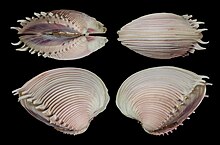Pitar dione
| Pitar dione | |
|---|---|
 |
|
| Scientific classification | |
| Kingdom: | Animalia |
| Phylum: | Mollusca |
| Class: | Bivalvia |
| Order: | Veneroida |
| Family: | Veneridae |
| Genus: | Pitar |
| Species: | P. dione |
| Binomial name | |
|
Pitar dione (Linnaeus, 1758) |
|
| Synonyms | |
|
|
Pitar (Hysteroconcha) dione, or the elegant Venus clam, formerly known as Venus dione, is a species of bivalve mollusc in the family Veneridae, the Venus clams. The shell is whitish pink, with a row of long curved spines on each valve.
The species was named in Systema Naturae in 1758 by the Swedish naturalist Linnaeus. Both there and in his 1771 Fundamenta Testaceologiae, he described the shell in "disquieting[ly]" sexual terms.
The species was named in 1758 by the Swedish naturalist Linnaeus as Venus dione, Venus being the name of the Roman goddess of love, and especially of sex.
The specific epithet dione is the name of the mother of Venus in Roman mythology. The later generic name Hysteroconcha is from Greek hyster, womb, and Latin concha, shell.
In his 1758 Systema Naturae, and then in his 1771 Fundamenta Testaceologiae, Linnaeus used a series of "disquieting[ly]" sexual terms to describe the shell: vulva, anus, nates (), pubis, mons veneris, labia, hymen. The evolutionary biologist Stephen Jay Gould called Linnaeus's description "one of the most remarkable paragraphs in the history of systematics". Some later naturalists found the terms used by Linnaeus uncomfortable; an 1803 review commented that "a few of these terms however strongly they may be warranted by the similitudes and analogies which they express, ... are not altogether reconcilable with the delicacy proper to be observed in ordinary discourse", while the 1824 Supplement to the Encyclopaedia Britannica criticised Linnaeus for "indulg[ing] in obscene allusions."
...
Wikipedia
